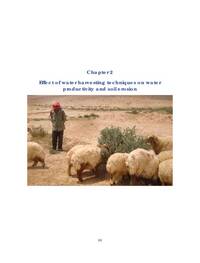Effect of water harvesting techniques on water productivity and soil erosion
Published Date
December 31, 2011
Type
Book Chapter

Authors:
Theib Yousef Oweis Oweis, Marwan Suifan, N. Shawahneh, Y. Sattar, Feras M. Ziadat, Adriana Bruggeman, Mohammed Karrou
The Jordan Badia is representative of the vast drier environments of the West Asia and North Africa (WANA) region. Pasture rangeland covers the majority of the Badia, although the vegetative cover is not dense. The vegetation in the Badia includes shrubs and short grasses. Barley is the main field crop in dryland farming, although irrigated forage, vegetables, and fruit orchards are also found in the Badia. Most of Jordan’s livestock (70%) is produced in the Badia.
Citation:
Mohammed Mudabber, Theib Oweis, Marwan Suifan, N. Shawahneh, Y. Sattar, Feras M. Ziadat, Adriana Bruggeman, Mohammed Karrou. (31/12/2011). Effect of water harvesting techniques on water productivity and soil erosion, in "Water Benchmarks of CWANA- Rehabilitation and integrated management of dry rangelands environments with water harvesting - Number 9". Aleppo, Syrian Arab Republic: National Agricultural Research Center Jordan (NARC Jordan).
Keywords:
benchmark sites
gis mapping
west asia
drought
farming systems
impact assessment
land use
livestock
rangelands
soil
water
water harvesting
soil erosion
natural resources
techniques
water productivity
socioeconomics
